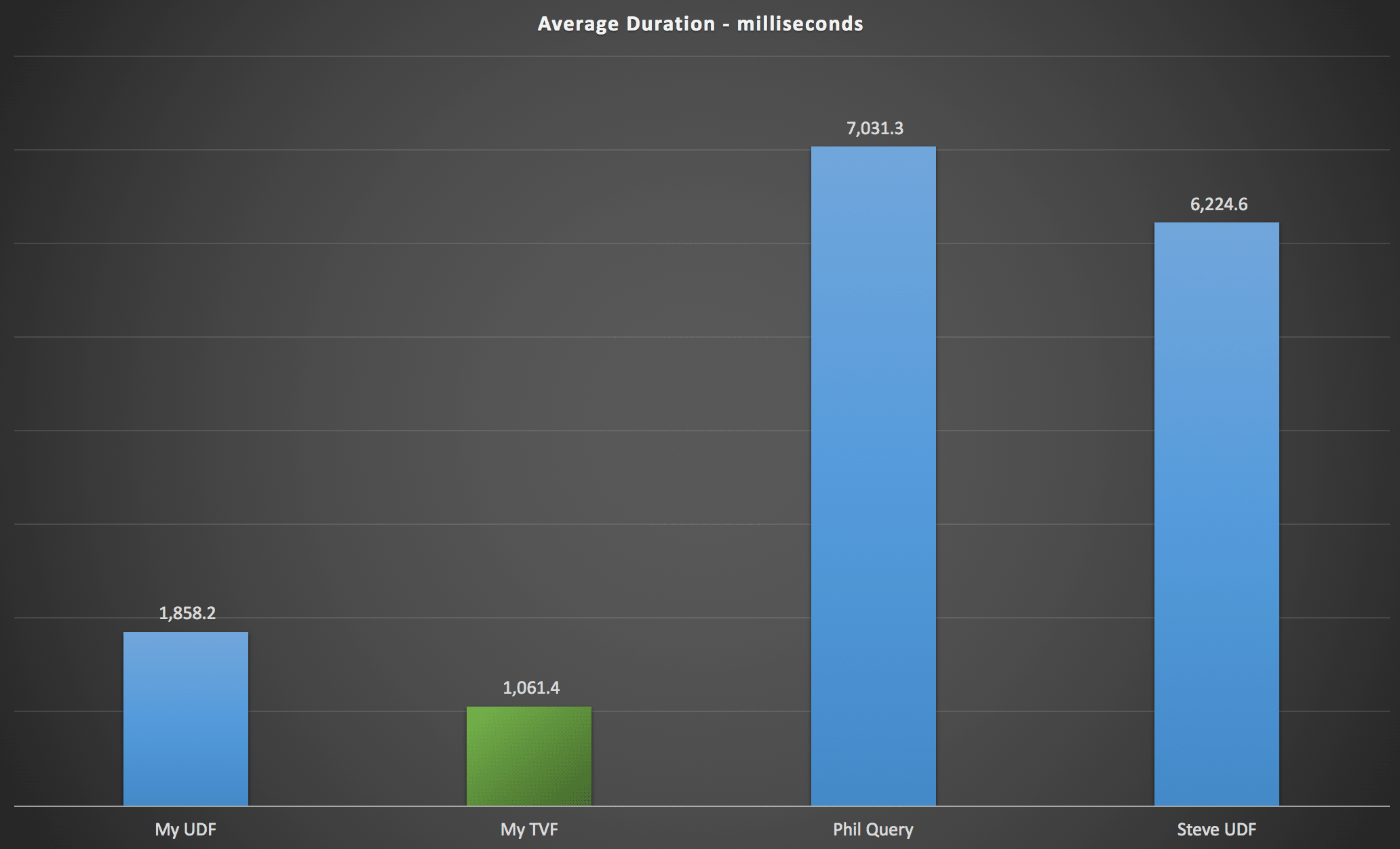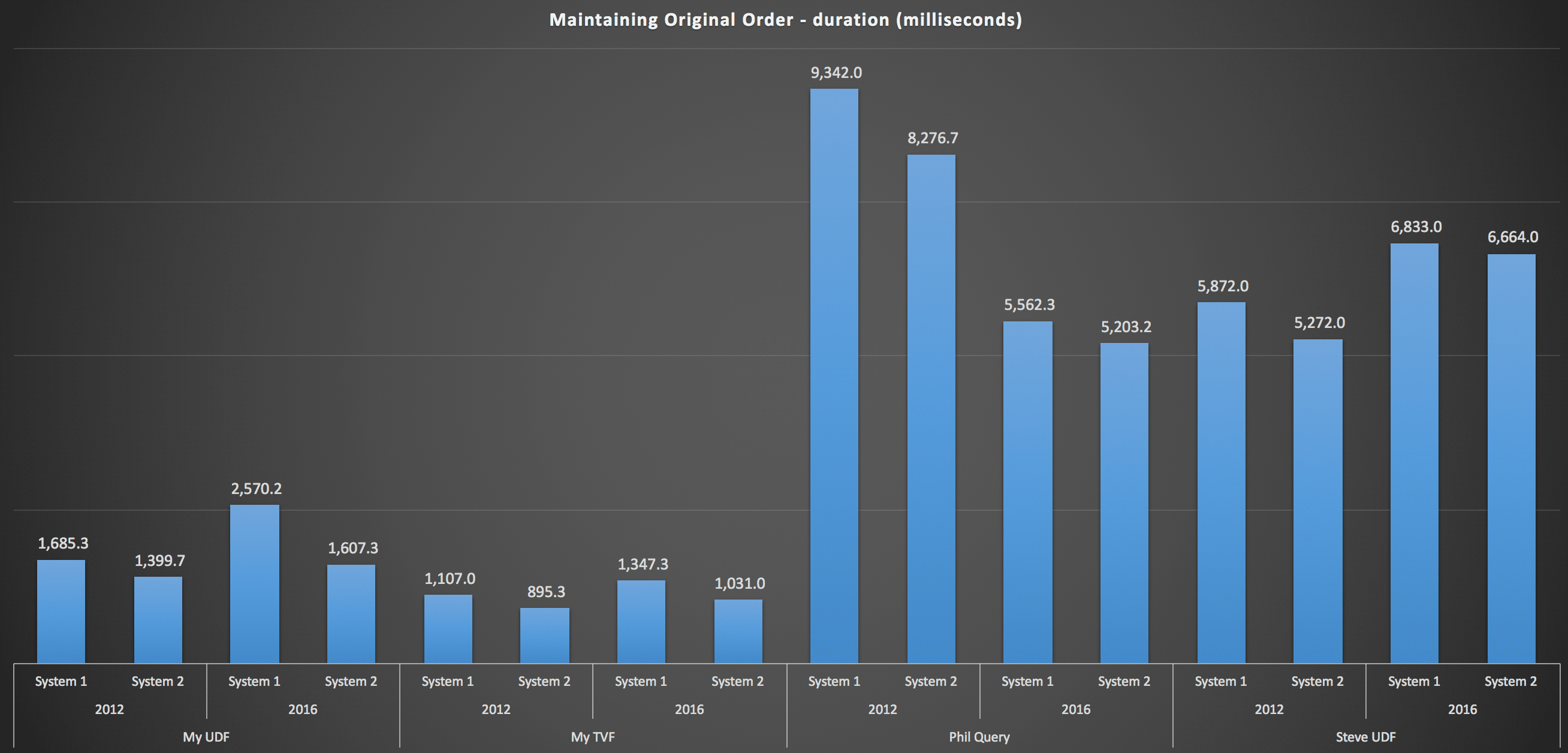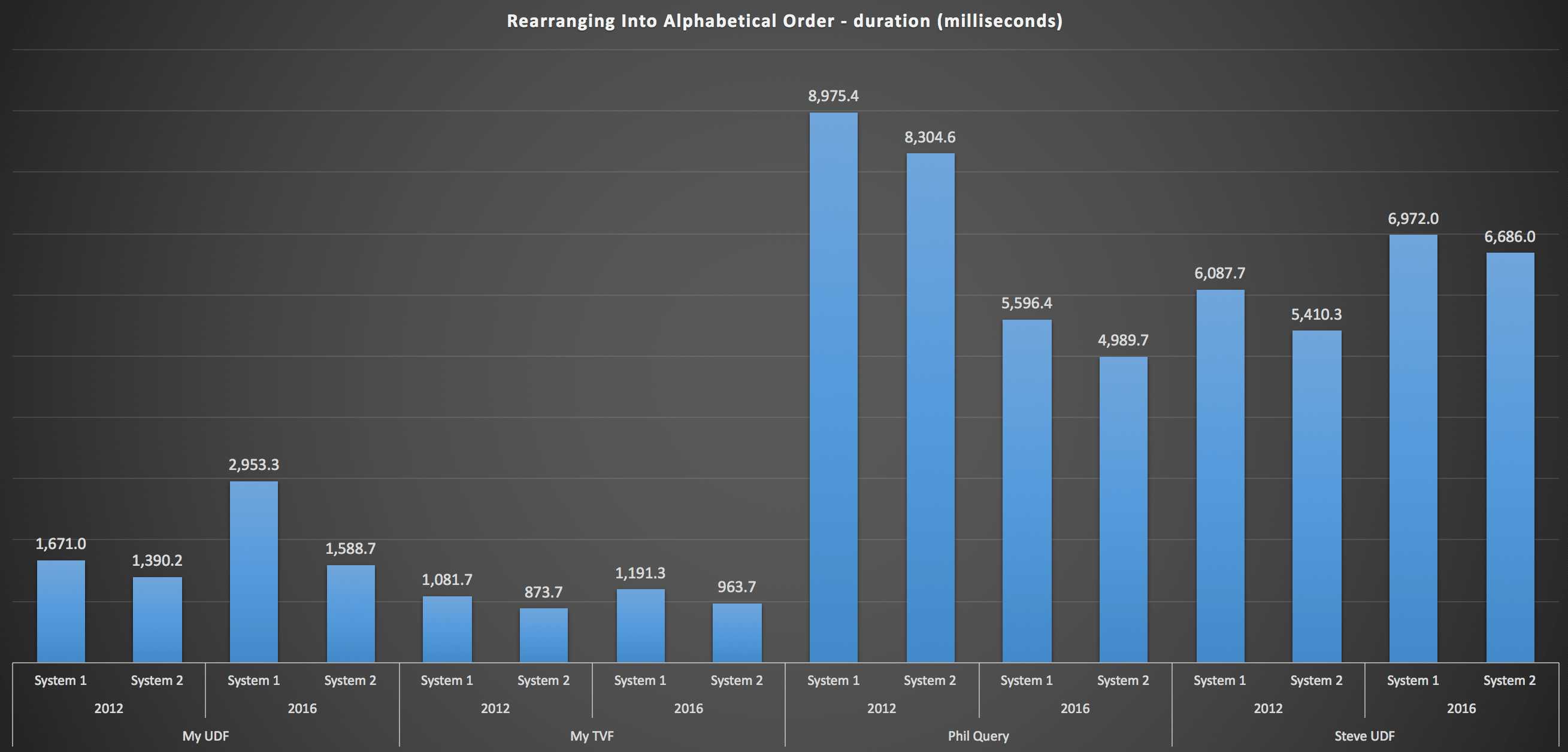Earlier this month, I published a tip about something we probably all wish we didn't have to do: sort or remove duplicates from delimited strings, typically involving user-defined functions (UDFs). Sometimes you need to reassemble the list (without the duplicates) in alphabetical order, and sometimes you may need to maintain the original order (it could be the list of key columns in a bad index, for example).
For my solution, which addresses both scenarios, I used a numbers table, along with a pair of user-defined functions (UDFs) – one to split the string, the other to reassemble it. You can see that tip here:
Of course, there are multiple ways to solve this problem; I was merely providing one method to try if you're stuck with that structure data. Red-Gate's @Phil_Factor followed up with a quick post showing his approach, which avoids the functions and the numbers table, opting instead for inline XML manipulation. He says he prefers having single-statement queries and avoiding both functions and row-by-row processing:
Then a reader, Steve Mangiameli, posted a looping solution as a comment on the tip. His reasoning was that the use of a numbers table seemed over-engineered to him.
The three of us all failed to address an aspect of this that is usually going to be quite important if you're performing the task often enough or at any level of scale: performance.
Testing
Curious to see how well the inline XML and looping approaches would perform compared to my numbers table-based solution, I constructed a fictitious table to perform some tests; my goal was 5,000 rows, with an average string length of greater than 250 characters, and at least 10 elements in each string. With a very short cycle of experiments, I was able to achieve something very close to this with the following code:
CREATE TABLE dbo.SourceTable ( [RowID] int IDENTITY(1,1) PRIMARY KEY CLUSTERED, DelimitedString varchar(8000) ); GO ;WITH s(s) AS ( SELECT TOP (250) o.name + REPLACE(REPLACE(REPLACE(REPLACE(REPLACE( ( SELECT N'/column_' + c.name FROM sys.all_columns AS c WHERE c.[object_id] = o.[object_id] ORDER BY NEWID() FOR XML PATH(N''), TYPE).value(N'.[1]', N'nvarchar(max)' ), -- make fake duplicates using 5 most common column names: N'/column_name/', N'/name/name/foo/name/name/id/name/'), N'/column_status/', N'/id/status/blat/status/foo/status/name/'), N'/column_type/', N'/type/id/name/type/id/name/status/id/type/'), N'/column_object_id/', N'/object_id/blat/object_id/status/type/name/'), N'/column_pdw_node_id/', N'/pdw_node_id/name/pdw_node_id/name/type/name/') FROM sys.all_objects AS o WHERE EXISTS ( SELECT 1 FROM sys.all_columns AS c WHERE c.[object_id] = o.[object_id] ) ORDER BY NEWID() ) INSERT dbo.SourceTable(DelimitedString) SELECT s FROM s; GO 20
This produced a table with sample rows looking like this (values truncated):
RowID DelimitedString ----- --------------- 1 master_files/column_redo_target_fork_guid/.../column_differential_base_lsn/... 2 allocation_units/column_used_pages/.../column_data_space_id/type/id/name/type/... 3 foreign_key_columns/column_parent_object_id/column_constraint_object_id/...
The data as a whole had the following profile, which should be good enough to uncover any potential performance issues:
;WITH cte([Length], ElementCount) AS ( SELECT 1.0*LEN(DelimitedString), 1.0*LEN(REPLACE(DelimitedString,'/','')) FROM dbo.SourceTable ) SELECT row_count = COUNT(*), avg_size = AVG([Length]), max_size = MAX([Length]), avg_elements = AVG(1 + [Length]-[ElementCount]), sum_elements = SUM(1 + [Length]-[ElementCount]) FROM cte; EXEC sys.sp_spaceused N'dbo.SourceTable'; /* results (numbers may vary slightly, depending on SQL Server version the user objects in your database): row_count avg_size max_size avg_elements sum_elements --------- ---------- -------- ------------ ------------ 5000 299.559000 2905.0 17.650000 88250.0 reserved data index_size unused -------- ------- ---------- ------ 1672 KB 1648 KB 16 KB 8 KB */
Note that I switched to varchar here from nvarchar in the original article, because the samples Phil and Steve supplied assumed varchar, strings capping out at only 255 or 8000 characters, single-character delimiters, etc. I've learned my lesson the hard way, that if you're going to take someone's function and include it in performance comparisons, you change as little as possible – ideally nothing. In reality I would always use nvarchar and not assume anything about the longest string possible. In this case I knew I wasn't losing any data because the longest string is only 2,905 characters, and in this database I don't have any tables or columns that use Unicode characters.
Next, I created my functions (which require a numbers table). A reader spotted an issue in the function in my tip, where I assumed that the delimiter would always be a single character, and corrected that here. I also converted just about everything to varchar(8000) to level the playing field in terms of string types and lengths.
DECLARE @UpperLimit INT = 1000000; ;WITH n(rn) AS ( SELECT ROW_NUMBER() OVER (ORDER BY s1.[object_id]) FROM sys.all_columns AS s1 CROSS JOIN sys.all_columns AS s2 ) SELECT [Number] = rn INTO dbo.Numbers FROM n WHERE rn <= @UpperLimit; CREATE UNIQUE CLUSTERED INDEX n ON dbo.Numbers([Number]); GO CREATE FUNCTION [dbo].[SplitString] -- inline TVF ( @List varchar(8000), @Delim varchar(32) ) RETURNS TABLE WITH SCHEMABINDING AS RETURN ( SELECT rn, vn = ROW_NUMBER() OVER (PARTITION BY [Value] ORDER BY rn), [Value] FROM ( SELECT rn = ROW_NUMBER() OVER (ORDER BY CHARINDEX(@Delim, @List + @Delim)), [Value] = LTRIM(RTRIM(SUBSTRING(@List, [Number], CHARINDEX(@Delim, @List + @Delim, [Number]) - [Number]))) FROM dbo.Numbers WHERE Number <= LEN(@List) AND SUBSTRING(@Delim + @List, [Number], LEN(@Delim)) = @Delim ) AS x ); GO CREATE FUNCTION [dbo].[ReassembleString] -- scalar UDF ( @List varchar(8000), @Delim varchar(32), @Sort varchar(32) ) RETURNS varchar(8000) WITH SCHEMABINDING AS BEGIN RETURN ( SELECT newval = STUFF(( SELECT @Delim + x.[Value] FROM dbo.SplitString(@List, @Delim) AS x WHERE (x.vn = 1) -- filter out duplicates ORDER BY CASE @Sort WHEN 'OriginalOrder' THEN CONVERT(int, x.rn) WHEN 'Alphabetical' THEN CONVERT(varchar(8000), x.[Value]) ELSE CONVERT(SQL_VARIANT, NULL) END FOR XML PATH, TYPE).value(N'.[1]',N'varchar(8000)'),1,LEN(@Delim),'') ); END GO
Next, I created a single, inline table-valued function that combined the two functions above, something I now wish I had done in the original article, in order to avoid the scalar function altogether. (While true that not all scalar functions are terrible at scale, there are very few exceptions.)
CREATE FUNCTION [dbo].[RebuildString] ( @List varchar(8000), @Delim varchar(32), @Sort varchar(32) ) RETURNS TABLE WITH SCHEMABINDING AS RETURN ( SELECT [Output] = STUFF(( SELECT @Delim + x.[Value] FROM ( SELECT rn, [Value], vn = ROW_NUMBER() OVER (PARTITION BY [Value] ORDER BY rn) FROM ( SELECT rn = ROW_NUMBER() OVER (ORDER BY CHARINDEX(@Delim, @List + @Delim)), [Value] = LTRIM(RTRIM(SUBSTRING(@List, [Number], CHARINDEX(@Delim, @List + @Delim, [Number]) - [Number]))) FROM dbo.Numbers WHERE Number <= LEN(@List) AND SUBSTRING(@Delim + @List, [Number], LEN(@Delim)) = @Delim ) AS y ) AS x WHERE (x.vn = 1) ORDER BY CASE @Sort WHEN 'OriginalOrder' THEN CONVERT(int, x.rn) WHEN 'Alphabetical' THEN CONVERT(varchar(8000), x.[Value]) ELSE CONVERT(sql_variant, NULL) END FOR XML PATH, TYPE).value(N'.[1]',N'varchar(8000)'),1,LEN(@Delim),'') ); GO
I also created separate versions of the inline TVF that were dedicated to each of the two sorting choices, in order to avoid the volatility of the CASE expression, but it turned out to not have a dramatic impact at all.
Then I created Steve's two functions:
CREATE FUNCTION [dbo].[gfn_ParseList] -- multi-statement TVF (@strToPars VARCHAR(8000), @parseChar CHAR(1)) RETURNS @parsedIDs TABLE (ParsedValue VARCHAR(255), PositionID INT IDENTITY) AS BEGIN DECLARE @startPos INT = 0 , @strLen INT = 0 WHILE LEN(@strToPars) >= @startPos BEGIN IF (SELECT CHARINDEX(@parseChar,@strToPars,(@startPos+1))) > @startPos SELECT @strLen = CHARINDEX(@parseChar,@strToPars,(@startPos+1)) - @startPos ELSE BEGIN SET @strLen = LEN(@strToPars) - (@startPos -1) INSERT @parsedIDs SELECT RTRIM(LTRIM(SUBSTRING(@strToPars,@startPos, @strLen))) BREAK END SELECT @strLen = CHARINDEX(@parseChar,@strToPars,(@startPos+1)) - @startPos INSERT @parsedIDs SELECT RTRIM(LTRIM(SUBSTRING(@strToPars,@startPos, @strLen))) SET @startPos = @startPos+@strLen+1 END RETURN END GO CREATE FUNCTION [dbo].[ufn_DedupeString] -- scalar UDF ( @dupeStr VARCHAR(MAX), @strDelimiter CHAR(1), @maintainOrder BIT ) -- can't possibly return nvarchar, but I'm not touching it RETURNS NVARCHAR(MAX) AS BEGIN DECLARE @tblStr2Tbl TABLE (ParsedValue VARCHAR(255), PositionID INT); DECLARE @tblDeDupeMe TABLE (ParsedValue VARCHAR(255), PositionID INT); INSERT @tblStr2Tbl SELECT DISTINCT ParsedValue, PositionID FROM dbo.gfn_ParseList(@dupeStr,@strDelimiter); WITH cteUniqueValues AS ( SELECT DISTINCT ParsedValue FROM @tblStr2Tbl ) INSERT @tblDeDupeMe SELECT d.ParsedValue , CASE @maintainOrder WHEN 1 THEN MIN(d.PositionID) ELSE ROW_NUMBER() OVER (ORDER BY d.ParsedValue) END AS PositionID FROM cteUniqueValues u JOIN @tblStr2Tbl d ON d.ParsedValue=u.ParsedValue GROUP BY d.ParsedValue ORDER BY d.ParsedValue DECLARE @valCount INT , @curValue VARCHAR(255) ='' , @posValue INT=0 , @dedupedStr VARCHAR(4000)=''; SELECT @valCount = COUNT(1) FROM @tblDeDupeMe; WHILE @valCount > 0 BEGIN SELECT @posValue=a.minPos, @curValue=d.ParsedValue FROM (SELECT MIN(PositionID) minPos FROM @tblDeDupeMe WHERE PositionID > @posValue) a JOIN @tblDeDupeMe d ON d.PositionID=a.minPos; SET @dedupedStr+=@curValue; SET @valCount-=1; IF @valCount > 0 SET @dedupedStr+='/'; END RETURN @dedupedStr; END GO
Then I put Phil's direct queries into my test rig (note that his queries encode < as < to protect them from XML parsing errors, but they don't encode > or & – I've added placeholders in case you need to guard against strings that can potentially contain those problematic characters):
-- Phil's query for maintaining original order SELECT /*the re-assembled list*/ stuff( (SELECT '/'+TheValue FROM (SELECT x.y.value('.','varchar(20)') AS Thevalue, row_number() OVER (ORDER BY (SELECT 1)) AS TheOrder FROM XMLList.nodes('/list/i/text()') AS x ( y ) )Nodes(Thevalue,TheOrder) GROUP BY TheValue ORDER BY min(TheOrder) FOR XML PATH('') ),1,1,'') as Deduplicated FROM (/*XML version of the original list*/ SELECT convert(XML,'<list><i>' --+replace(replace( +replace(replace(ASCIIList,'<','<') --,'>','>'),'&','&') ,'/','</i><i>')+'</i></list>') FROM (SELECT DelimitedString FROM dbo.SourceTable )XMLlist(AsciiList) )lists(XMLlist); -- Phil's query for alpha SELECT stuff( (SELECT DISTINCT '/'+x.y.value('.','varchar(20)') FROM XMLList.nodes('/list/i/text()') AS x ( y ) FOR XML PATH('')),1,1,'') as Deduplicated FROM ( SELECT convert(XML,'<list><i>' --+replace(replace( +replace(replace(ASCIIList,'<','<') --,'>','>'),'&','&') ,'/','</i><i>')+'</i></list>') FROM (SELECT AsciiList FROM (SELECT DelimitedString FROM dbo.SourceTable)ListsWithDuplicates(AsciiList) )XMLlist(AsciiList) )lists(XMLlist);
The test rig was basically those two queries, and also the following function calls. Once I validated that they all returned the same data, I interspersed the script with DATEDIFF output and logged it to a table:
-- Maintain original order -- My UDF/TVF pair from the original article SELECT UDF_Original = dbo.ReassembleString(DelimitedString, '/', 'OriginalOrder') FROM dbo.SourceTable ORDER BY RowID; -- My inline TVF based on the original article SELECT TVF_Original = f.[Output] FROM dbo.SourceTable AS t CROSS APPLY dbo.RebuildString(t.DelimitedString, '/', 'OriginalOrder') AS f ORDER BY t.RowID; -- Steve's UDF/TVF pair: SELECT Steve_Original = dbo.ufn_DedupeString(DelimitedString, '/', 1) FROM dbo.SourceTable; -- Phil's first query from above -- Reassemble in alphabetical order -- My UDF/TVF pair from the original article SELECT UDF_Alpha = dbo.ReassembleString(DelimitedString, '/', 'Alphabetical') FROM dbo.SourceTable ORDER BY RowID; -- My inline TVF based on the original article SELECT TVF_Alpha = f.[Output] FROM dbo.SourceTable AS t CROSS APPLY dbo.RebuildString(t.DelimitedString, '/', 'Alphabetical') AS f ORDER BY t.RowID; -- Steve's UDF/TVF pair: SELECT Steve_Alpha = dbo.ufn_DedupeString(DelimitedString, '/', 0) FROM dbo.SourceTable; -- Phil's second query from above
And then I ran performance tests on two different systems (one quad core with 8GB, and one 8-core VM with 32GB), and in each case, on both SQL Server 2012 and SQL Server 2016 CTP 3.2 (13.0.900.73).
Results
The results I observed are summarized in the following chart, which shows duration in milliseconds of each type of query, averaged over alphabetical and original order, the four server/version combinations, and a series of 15 executions for each permutation. Click to enlarge:
This shows that the numbers table, while deemed over-engineered, actually yielded the most efficient solution (at least in terms of duration). This was better, of course, with the single TVF that I implemented more recently than with the nested functions from the original article, but both solutions run circles around the two alternatives.
To get into more detail, here are the breakdowns for each machine, version, and query type, for maintaining original order:
…and for reassembling the list in alphabetical order:
These show that the sorting choice had little impact on the outcome – both charts are virtually identical. And that makes sense because, given the form of the input data, there is no index I can envision that would make the sorting more efficient – it's an iterative approach no matter how you slice it or how you return the data. But it's clear that some iterative approaches can be generally worse than others, and it's not necessarily the use of a UDF (or a table of numbers) that makes them that way.
Conclusion
Until we have native split and concatenation functionality in SQL Server, we are going to use all kinds of unintuitive methods to get the job done, including user-defined functions. If you're handling a single string at a time, you're not going to see much difference. But as your data scales up, it will be worth your while to test various approaches (and I am by no means suggesting that the methods above are the best you'll find – I didn't even look at CLR, for example, or other T-SQL approaches from this series).
The post Comparing string splitting / concatenation methods appeared first on SQLPerformance.com.


